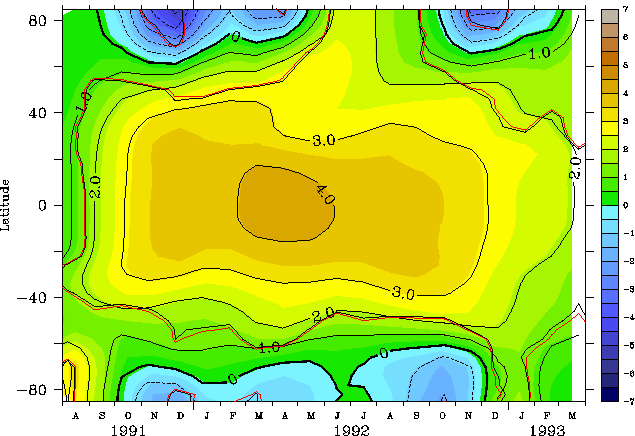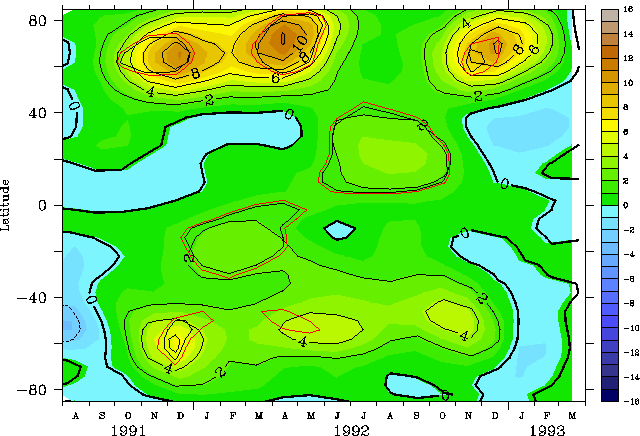
Previous: Chemical composition in the lower stratosphere Next: December 1991 Up: Ext. Abst.
4. Temperature and zonal wind in the lower stratosphere
The time-latitude cross-section of the temperature change in the lower stratosphere (at 30 hPa) simulated by the model is presented in Figure 8. The main features of the simulated temperature changes are the warming by up to 4.5K) of the lower stratosphere in the wide area from 40°S to 40°N due to the absorption of solar near-infrared and longwave radiation by the aerosol (e.g., Stenchikov et al., [1998]; Andronova et al., [1999]), the dynamically driven warming during the summer season over middle and high latitudes of both hemispheres, and the cooling over the high latitudes during the winter and spring seasons resulting from the intensification of the polar-night jets. {How does this work?} All the above-mentioned changes also occur in the lower stratosphere up to 100 hPa, and they are statistically significant.

Figure 8. Changes (K) of the monthly zonal-mean temperature at 30 hPa after the eruption.
Angell [1997a] also demonstrated the significant influence of the volcanic aerosol on the temperature in the stratosphere. He found that the largest warming after the Pinatubo eruption, of up to 3K after extraction of the QBO signal, occurred in the tropics between 50 hPa and 100 hPa. He has also shown that some cooling in the high latitudes of the lower stratosphere took place following the Pinatubo eruption. These results have been confirmed by Kirchner et al. [1999] and Yang [1999] on the basis of temperature-anomaly analyses during the Post-Pinatubo period relative to the 1968-1997 NCEP climatology.
The simulated temperature changes presented here are close to those simulated by Kirchner et al. [1999] with the ECHAM-4 GCM forced by a similar radiative aerosol forcing. It was pointed out by Kirchner et al. [1999] that the ozone-depletion effect may reduce the magnitude of the simulated warming in the stratosphere. However, according to our results the ozone depletion simulated by our model in the lower stratosphere is not large enough to substantially cool the stratosphere. The almost exact coincidence of our results with the warming obtained by Kirchner et al. [1999] allows us to conclude that the direct radiative heating by the aerosol most likely determines the magnitude of the lower stratosphere warming. Therefore, the causes of disagreement between model simulations and analysis of the observations could be connected with the parameterization of the aerosol physical or/and radiative properties.
As illustrated Figure 9, he simulated warming of the stratosphere and the consequent increase in the pole-to-equator temperature difference leads to the intensification of the polar night jets (PNJs) The change in the zonal-wind intensities are more pronounced (up to 10 m/s) in the Northern Hemisphere than in the Southern Hemisphere and are statistically significant in December 1991, April 1991 and December 1993. In the Southern Hemisphere the acceleration of the zonal wind is significant only in December 1991.

Figure 9. Changes (m/s) of the monthly zonal-mean zonal wind at 30 hPa after the eruption.